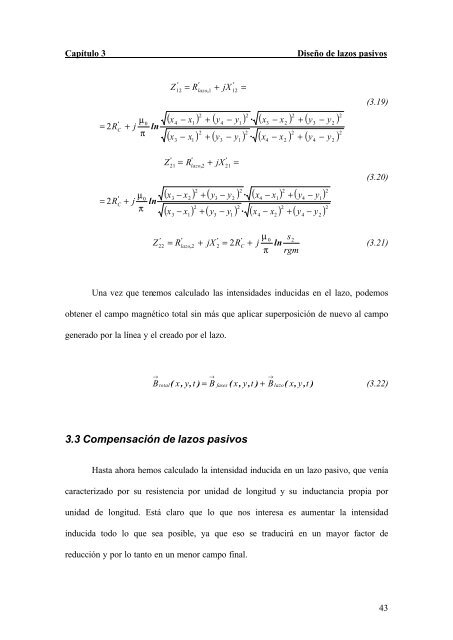Índice General - Index of - Universidad de Sevilla
Índice General - Index of - Universidad de Sevilla
Índice General - Index of - Universidad de Sevilla
Create successful ePaper yourself
Turn your PDF publications into a flip-book with our unique Google optimized e-Paper software.
Capítulo 3 Diseño <strong>de</strong> lazos pasivos<br />
= 2R<br />
= 2R<br />
'<br />
C<br />
'<br />
C<br />
μ0<br />
+ j ln<br />
π<br />
μ0<br />
+ j ln<br />
π<br />
Z<br />
'<br />
12<br />
( ) ( ) ( ) ( )<br />
( ) ( ) ( ) ( ) 2<br />
x4<br />
2<br />
− x1<br />
+ y4<br />
2<br />
− y1<br />
· x3<br />
2<br />
− x2<br />
+ y3<br />
2<br />
− y2<br />
x − x<br />
2<br />
+ y<br />
2<br />
− y · x − x<br />
2<br />
+ y − y<br />
Z<br />
3<br />
'<br />
21<br />
= R<br />
1<br />
'<br />
lazo,<br />
1<br />
+<br />
3<br />
jX<br />
'<br />
12<br />
1<br />
=<br />
( ) ( ) ( ) ( )<br />
( ) ( ) ( ) ( ) 2<br />
2<br />
x3<br />
− x2<br />
2<br />
+ y3<br />
− y2<br />
· x4<br />
2<br />
− x1<br />
+ y4<br />
2<br />
− y1<br />
x − x<br />
2<br />
+ y<br />
2<br />
− y · x − x<br />
2<br />
+ y − y<br />
3<br />
= R<br />
1<br />
'<br />
lazo,<br />
2<br />
+<br />
3<br />
jX<br />
'<br />
21<br />
1<br />
=<br />
4<br />
4<br />
2<br />
2<br />
4<br />
4<br />
2<br />
2<br />
(3.19)<br />
(3.20)<br />
' '<br />
' ' μ 0 s2<br />
22 = Rlazo,<br />
2 + jX 2 = 2R + j ln<br />
(3.21)<br />
π rgm<br />
Z C<br />
Una vez que tenemos calculado las intensida<strong>de</strong>s inducidas en el lazo, po<strong>de</strong>mos<br />
obtener el campo magnético total sin más que aplicar superposición <strong>de</strong> nuevo al campo<br />
generado por la línea y el creado por el lazo.<br />
→<br />
→<br />
→<br />
Btotal lazo<br />
3.3 Compensación <strong>de</strong> lazos pasivos<br />
( x,<br />
y,<br />
t ) = B fases ( x,<br />
y,<br />
t ) + B ( x,<br />
y,<br />
t )<br />
(3.22)<br />
Hasta ahora hemos calculado la intensidad inducida en un lazo pasivo, que venía<br />
caracterizado por su resistencia por unidad <strong>de</strong> longitud y su inductancia propia por<br />
unidad <strong>de</strong> longitud. Está claro que lo que nos interesa es aumentar la intensidad<br />
inducida todo lo que sea posible, ya que eso se traducirá en un mayor factor <strong>de</strong><br />
reducción y por lo tanto en un menor campo final.<br />
43


